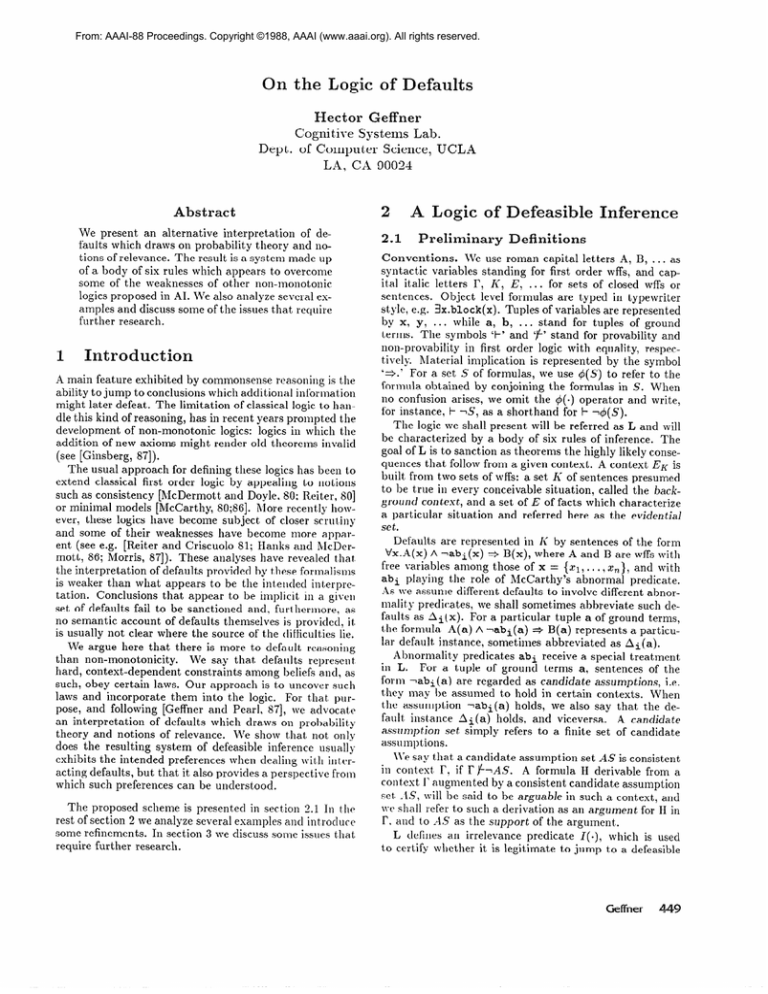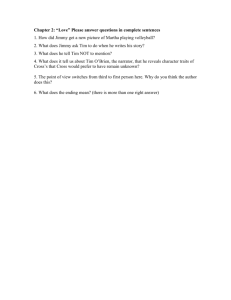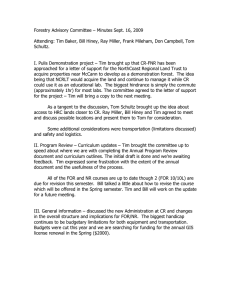
From: AAAI-88 Proceedings. Copyright ©1988, AAAI (www.aaai.org). All rights reserved.
On the Logic of Defaults
Hector
Cog;nit.iYe
Dept.
of Coil~I>~~t,er
L-4,
CA
Abstract
We present
an alternative
int’erpretation
of defaults which draws on probability
theory and notions of relevance.
The result is a syst,em made up
of a body of six rules which appears t’o overcome
some of the weaknesses
of other non-monotonic
logics proposed in AI. We also analyze several examples and discuss some of the issues t#hat require
further research.
1
Geffner
Systeills
Introduction
A main feature exhibited
by commonsense
reasoning is the
ability to jump to conclusions
which additional
informat,ion
might later defeat. The limitation
of classical logic to handle this kind of reasoning,
has in recent years prompted the
development
of non-monotonic
logics: logics in which the
addition of new axioms might render old theorems
invalid
(see [Ginsberg,
871).
The usual approach for defining these logics has been t,o
extend classical
first order logic by appealing
to notions
such as consistency
[McDermott
and Doyle. 80; Reiter, SO]
or minimal models [McCarthy,
SO;SS]. More recent,ly however, these logics have become subject
of closer scrut,iny
and some of their weaknesses
have become more apparent (see e.g. [Reiter and Criscuolo
Sl; Hanks and McDcrmott, 86; Morris, 871). These analyses have revealed that
the interpretation
of defa.ults provided by t,hese formalisms
is weaker than what appears t,o be the int8el&d
inlerpretation.
Conclusions
that appf2a.r to be implicit
in a give11
set of defaults fail to be sanctioned
and, furthermore,
as
no semantic
account of defaults themselves
is provided, it,
is usually not clear where the source of the clifflculties
lie.
We argue here that there is more to default rcar;oning
than non-monotonicity.
We sa.y tl1a.t defalllts
represent
hard, context-dependent
constraints
among beliefs and, as
such, obey certain laws. Our approach
is t.o uncover such
laws and incorporate
them into t,he logic.
For t,hat purpose, and following
[Geffner and Pearl, 871, we advocate
an interpretation
of defaults
which draws on probabili t,y
theory and notions of relevance.
We show that not only
does the resulting
system
of defeasible
inference
usua.lly
exhibits the intended preferences
when dealing wit,h intcracting defaults, but that it also provides a perspective
from
which such preferences
can be understood.
The proposed scheme is present,ecl in section 3.1 In the
rest of section 2 we analyze several examples and introduce
some refinements.
In sect,ion 3 we discuss sonic issues t,hat,
require further research.
Lab.
Science,
UCLA
900%
2
2.1
A Logic of Defeasible
Preliminary
Inference
Definitions
Conventions. 1lr, use roman capital letters A, B, . . . as
syntactic
variables
standing
for first order wffs, and capit,al it,alic letters
I’, K, E, . . . for sets of closed wffs or
sentences.
Object
level formulas
are typed in typewriter
st,yle, e.g. gx.block(x).
Tuples of variables are represented
by x, y, . . . while a, b, . . . stand for tuples of ground
terms.
The symbols ‘I-’ and ‘f’ stand for provability
and
non-provability
in first order logic with equality,
respectively.
Matserial implication
is represented
by the symbol
‘3.‘
For a set S of formulas,
we use d(S) to refer to the
formula obtained
by conjoining
the formulas in S. When
no confusion
arises, we omit the #(.) operator
and write,
for instance,
I- YS, as a shorthand
for I- ‘d(S).
The logic we shall present will be referred as L and will
be characterized
by a body of six rules of inference.
The
goal of L is to sanction as theorems the highly likely consequences that follow from a given context.
A context Efc is
built from two sets of wffs: a set I{ of sentences
presumed
to be true in every conceivable
situation,
called the background contest,
and a set of E of facts which characterize
a particular
situation
and referred here as the evidential
set.
Defaults
are represented
in I< by sentences
of the form
Vx.A(x)
A labi
=+ B(x), where A and B are wffs with
free variables among those of x = (~1, . ..) z,},
and with
abi playing the role of McCarthy’s
abnormal
predicate.
As we assunle different defaults to involve different abnormalit,y predicates,
we shall sometimes
abbreviate
such defaults as Ai(
For a particular
tuple a of ground terms,
the formula
A(a) A labi
=+ B(a) represents
a particular default, instance,
sometimes
abbrevia.ted
as Ai(
Abnormality
predicates
abi receive a special treatment
in L.
For a tuple of ground terms a, sentences
of the
form labi
are regarded as candidate assumptions, i.e.
they may be assumed to hold in certain contexts.
When
the assumption
Tabi
holds, we also say that the default, instance
Ai
holds, and viceversa.
A candidate
assumption
sel; simply refers to a finite set of candidate
assumptions.
\1’e say that. a candidate
assumption
set AS is consistent
in context
I’, if I-‘&AS.
A formula
H derivable
from a
cont,ext r augmented
by a consistent
candidate
assumption
set. .-1S, will be said to be arguable in such a context, and
wc‘shall refer to such a derivation
as an argument
for II in
I’, and to -AS as the support of the argument,.
L defines an irrelevance
predicate
I(.),
t.o certify whether it is legitimate
to jump
which is used
to a defeasible
Ciefher
fM@
conclusion
in a given context.
Roughly,
the idea is that if
H represents
an assumption
believed in context
I’, and E’
represents
an additional
body of evidence,
then belief in
H is .authorized
to persist as long as E’ does not provide
additional
support
for H’s negation,
or, as we shall say,
when E’ is irrelevant
to -H in context I’. This is captured
by the following definition:
Definition. A set of sentences E’ is said to be
irrelevant
to a sentence
H in context
I’, written
assumption
set
I(H; E’lr),
iff f or any candidate
AS, such that E’, X’)LyAS and E’, I’, AS I- H, we
also have that I’, AS I- H.
Vx.B(x)
A labi
+
F(x)
(2)
Vx.P(x)
A labs(x)
j
-F(x)
(3)
Vx.P(x)
=S- B(x)
(4)
vx.CB(x)
3
‘signs’
in Ii.
As for the most part the background
context will remain
fixed, we will find useful to abbreviate
I(H; E’JI?), with
I? = EK , as 1~ (H; E’ 1E). We also say that E’ is relevant
to H in context
I’, whenever I(H; E/II’) does not hold.
2.2
This definition
of irrelevance
possesses
a convenient
graphical
interpretation
we shall often exploit.
For instance,
fig. 1, depicts a background
context
K with formulas:
(1)
the example above, that, by virtue of the different
of the links converging
to F, B(t) is relevant to -P(t)
The
Rules
of Inference
The core of L is given by two sets of inference
rules. We
write I’ k H to denote that sentence
H is derivable
from
context
I’. Likewise,
I’, E’ b H states that H is derivable
from the context that results from augmenting
r with E’.
Notice that the provability
relation
associated
with the
symbol ‘ b ’ is not monotonic:
I?, E’ b H does not always
follow from I’ b H.
The first set of rules is given
by [Geffner
and Pearl,
871:
B(x)
Rule
1 (Logic Theorems)
If r I- H then I? b H
Rule 2 (Triangularity)
IfI’bH’andI’t-HthenI?,H’bII
CB
P
Rule 3 (Bayes)
If r t- H’ and r, H’ I- H then
Figure
1: B separates
CB from F, i.e. I(F(t);
CB(t)lIc,
I’ b H
B(t))
Rule 4 (Disjunction)
Paths in this type of graphs’ correspond
to arguments
and, irrelevance,
to a form of graph separation.2
For instance, the path CB 3 B + F suggests that for any particular individual
t, F(t) is derivable from CB(t), K, and any
labi(
Notice that
support
including
the assumption
provided any such support,
it is easy to verify that F(t)
can be also derived from B(t) and Ii, what amounts
t,o
say, considering
that there are no more pat.hs from CB to
F, that CB(t) is irrelevant
to F(t) in context
{B(t))rc,
i.e.
If I’,H’bH
and l?,H”i-H
then
I’,H’vH”kH
It can be shown [Pearl and Geffner,
$81 that the consequences
of each rule are guaranteed
to be highly likely
whenever its premises are. Similar rules were proposed by
Adams in his logic of conditionals
[Adams, 661.
Hereafter,
considering
that
mains fixed for the most part,
viate K, E k H as E k H.
the background
context
rewe will find useful to abbre-
I@(t);
CB(t)lK, B(t)).
Usually we will show a set of sentences
E’ to be irrelevant to a sentence
H in a context
EK, by showing tl1a.t in
the corresponding
graph, all the relevant paths that connect nodes corresponding
to formulas
in E’ to the node
that corresponds
to H, are mediated by E. Clearly in such
situations,
if from a given support,
H is not derivable from
E and K, H will be certainly
not derivable
from E, I<
and E’. We should keep in mind, however, that links ‘contrapose’.
So, a path from P to 1F not only represents
an
argument
for -F(t)
given P(t), but also an argument
for
-P(t)
given F(t).
Th e reader might verify for instance,
in
Rules l-4 express how conclusions
that hold in one context can be carried to a slightly different context provided
certain conditions
are satisfied.
They do not specify however, the contexts
under which candidate
assumptions
in
K, i.e. defa,ults, can be assumed
to hold.
In particular,
they do not authorize
to infer that Tweety
flies for instance, given that Tweety is a bird and that typically birds
fly. This issue is addressed
by another
pair of rules, the
first of which, specifies the initial context in which a given
candidate
assumption
might be assumed to hold, while the
second one uses such assumption
to ‘jump’ to conclusions
not refuted by the evidence.
‘In these graphs, we usually label the link tha.t correwith the index i, in order to facilitate
sponds to default Ai
reference.
2A similar corr es p ondence between graph separation and
conditional independence has been extensively exploited by
Judea Pearl in the context of probabilistic networks (see for
instance [Pearl and Verma, 871) We borrow here some of his
terminology.
Clearly, if Vx.A(x)
A labi
+ B(x) is a default in I(,
then for a tuple of ground terms a, it is reasonable
to assume labi
to hold when A(a) is all that is believed.
Each default,
however, is a belief in itself, not formed in
vacuum,
but on top of other relevant
and irrelevant
beliefs.
Here we assume Ii to partially
model such set of
beliefs for every default in it, thus, authorizing
for a default Vx.A(x)
A labi
Y?- B(x),
the following inference
60
Knowledge Representation
rule:34
Rule 5 (Assumptions)
If A(a), K )L abi(a)
then A(a), Ii’k labi
As we shall see, such assumption
turns out to be quite rear
sonable provided we restrict
K to contain only statements
whose truth does not depend on the particu1a.r context (e.g.
“penguins are birds”), leaving in E, the context dependent
information
available
(e.g. “Tweety flies99).5
Still, the rules above are not sufficient
for maintaining
derived conclusions
in the presence of additional,
but irrelevant information.
For instance,
while rules l-5 authorize
to conclude
that Tweety flies, given that it is a bird and
that birds typically fly, they fail to preserve such conclusion
color. This issue is addressed
upon learning, say, Tweety’s
by an additional
rule which appeals
to the notion of irrelevance
introduced
above.
The idea essentially
is that
a default
Vx.A(x)
h Tabi
=+ B(x)
permits
‘jumping’,
we know the relevant
say, from A(a) to B(a), whenever
labi
to hold, a,nd the new evidence
does
assumption
not provide an argument
supporting
its negation.
More
precisely:
Rule 6 (Irrelevance)
If
F, A(a) k labi
then I?, E’, A(a)
and I(abi(a);
iu B(a)
E’ll?, A(a)),
We argue below that what matters
when testing
the legitimacy
of inferring
B(a) from A(a) in context
I? when
coming to know E’, is not the existence
of arguments
in
support of abi(a)
but, more accurately,
the existence of arguments for abi(a)
in which the new information
E’ plays
a role. These are precisely
the arguments
which sa.nction
the relevance of E’ to abi(a).
In order to illustrate
this last point, consider for instance
a candidate
assumption
labi
believed
in context
I’.
Usually, in such context
there would be different
sets of
assumptions
ASi logically inconsistent
with labi(
For
instance,
in a context including
information
about the flying abilities
of penguins
and birds, the assumption
that,
corresponds
to the default instance
“if Tweety is a penguin
then it does not fly,” will be logically inconsistent
with the
assumption
that corresponds
to the default
instance
“if
Tweety is a bird then it flies,” whenever Tweety is known
to be a penguin.
In such cases, independently
of the new
E’, any argument
whose support includes any
information
of the sets of assumptions
ASi inconsistent
with labi
in I’, will automatically
constitute
an argument
for abi(a)
in the context
{I’, E’).
What the definition
of irrelevance
above simply does, is not to take those arguments
into a.ccount: for E’ to be relevant to abi(a)
in I’, there has to
3Note that rule 5 permits deriving B(a) from A(a), but,
not lA(a) from -B(a).
What amounts to say that the two
logically equivalent sentences Vx.A(x) A yabi(x) + B(x) and
VX.TB(X) A Tabi
j -A(X) are interpreted by L as encoding two different defaults. More about default contraposition
in sections 3 and 4.
4Tlze consistency test is for discarding from I< some of t.he
default instances otherwise implicit in the default, ‘schemas’ in
K, and its role should not be confused with the role consistency plays in other formalisms (e.g. [Reit,er, 80; McDermott.
and Doyle, SO]). That convention allows us to write a ‘uniquename hypothesis’ , for instance, as: vx.vy.labi(x,
y) 3 x # y,
without implying those default instances in which x = y.
‘More about this distinction in section 3.
be an argument
for abi(a)
with a support
AS’, logically
consistent
with labi
in r.
Note that in particular,
if Tabi
represents
an assumption
believed
in lr and ‘ah(b)
represents
an assumption
logically
inconsistent
with labi
in I’, i.e.
not only does L authorizes
to ‘ignore’
r, labi
l- abk(b),
the default instance
Ak(b) corresponding
to labk(b)
as
long as labi(a)
is believed 6, but to ignore such default
instance even in order to evaluate the relevance of new information
to abi(a).
We say in thoses cases that labi
dominates
the assumption
la&(b)
in I’, and thus, the
Ak(b).
default instance
Finally,
we summarize
a couple of meta-theorems
that
follow from the rules above, we shall later appeal to:7
Theorem
1 (Logical Closure)
If E k H, E k H’, and H, H’ I- H”, then
E h H”.
Theorem 2 (Except ions)
If E k H and E, H’ Ir, 1H then
2.3
E k 1H’.
Examples
Example
1 O Let us first consider a background
context
Ii in which it is known that both penguins (P) and circusbirds (CB) are birds (B), and that most birds fly (F), though
most penguins do not (Fig. 1):
Vx.B(x)
A labi
+
F(x)
Vx.P(x)
A labs(x)
j
lF(x)
Vx.P(x)
j
Vx.CB(x)
B(x)
=3 B(x)
Let us now say we learn about a penguin called Tim. We
can then conclude by means of rule 5 that Tabz(Tim)
holds
in context
{P(Tim)}K,
i.e. P(Tim) k labs(Tim).
Likewise,
being E closed under logical implication
(Theorem
l), we
can further conclude P(Tim) rY, yF(Tim).
Note that extending
the context
{P(Tim)}K
to include
B(Tim), does not affect either conclusion
since, by means
of rule 2 and the fact that P(Tim) k B(Tim) follows (rule
l), formulas that hold in context
{P(Tim))K,
can also be
shown to hold in the enhanced context
{P(Tim), B(Tim)}K.
III particular
thus, we obtain
P(Tim),
B(Tim)
k lF(Tim).
L does not authorize
reasoning
in the opposite
direction though.
While B(Tim) k labi(Tim)
and, as a consequence,
B(Tim) k F(Tim) can be derived, the conclusion
B(Tim), P(Tim) k F(T lm
’ ) cannot.
Nor is P(Tim) irrelevant
to abl(Tim)
in context
{B(Tim))K,
as the presence of an
argument
for abi(Tim)
in {B(Tim), P(Tim)}K
with support {labz(Tim)}
suggests,
nor is P(Tim) a consequence
of B(Tim).
Interestingly,
we also have that, in context
{P(Tim)}K,
the assumption
lab1 (Tim) is dominated by the assumption
--labs(Tim).
That is, we have both
P(Tim)
k labz(Tim)
and
P(Tim),-abz(Tim),K
I- abi(Tim).
‘Since, in such case, we can show r I- abk(b)
rules 1 and 3.
7See [Geffner and Pearl, 871 for proofs.
by means of
Gefier
451
Rule 6, as we discussed
above, can t,hen he lmderstood
as
asserting
that the default instance
Al(Tim) can be ignored
in order to evaluate whether it is legitimate
t.o ‘jump from
P(Tim) to lF(Tim)
in the presence of new facts. Or, more
graphically,
that the link connecting
B to F, in what Tim is
concerned,
can be ignored as long a.s labz(Tim)
is believed.
In particular
then, we have that, CB(Tim) turns out to be
irrelevant
to abs(Tim)
in context
{P(Tim)}K
and, thus, we
obtain
P(Tim),
CB(Tim)
k lF(Tim).
L might be also regarded as legitimizing
a weak form of
contraposition.
For instance,
by virtue of Theorem
3 and
the fact that we can derive both
B(Tim)
k F(Tim)
B(Tim),
P(Tim)
and
k lF(Tim),
we have that
B(Tim)
h lP(Tim),
also follows.
That is, if we assume a bird to fly, t~hough
we know that penguin-birds
do not fly, we are implicitly
assuming that the bird is not a penguin.
Stronger
forms of
contraposition,
as deriving -rB(Tim) from 7F( Tim) however,
are not sanctioned
by L.
Example
2.
Consider
the background
context
I< given
by the defaults:
Vx.P(x)
A labi
+ Q(x)
Vx.Q(x)
A labz(x)
+
R(x)
Vx.S(x)
A labz(x)
j
IR(x)
Clearly, for an individual
a, we can derive P(a) k labi (a)
and, thus, P(a) k Q(a). It t urns out however, that the conclusion Q(a) results defeated if +%(a) is learned in such context. This is due to the fact that, +a)
does provide aa argument for abl(a)
supported
by the assumption
labs(a),
and thus, IIc(abl(a);
+i(a)JP(a)) does not hold.
What this indicates is that while L does not consider dcfault contrapositives
to be strong enough as to aut,horize
deriving the negation of the antecedent
from the negat,ion
of the consequent,
L does consider default contraposit,ives
to be strong enough to make the latter relevant to the former, and thus precluding
certain inferences
to take place.
In terms of Nute [86], contrapositives
a.re trea.ted in L only
as defeaters.
Indeed, not only does L preclude deriving Q(a) from P(a)
when +(a)
is learned, but even when s(a) is. We find this
latter type of behavior
counterintuitive
though.”
In the
next subsection
we shall propose a refinement
of the delinition of the irrelevance
predicate
I(.) given above which
distinguishes
between the two situations.
2.4
Contrapositives
The way L handles contraposition
of defaults departs from
other frameworks
known to the author.
Except for a weak
form of contraposition,
L does not permit. to infer the negation of a default antecedent
from the negation
of its con‘This type of behavior is also exhibited by circumscription
and by Reiter’s default logic, when defaults are encoded as to
allow contraposition
(see [Morris, 871).
452
Knowledge Representation
sequent, though it makes the latter relevant to the former,
t,hus precluding
certain dubious derivations
to take place.
Still,
as we discussed
above,
contrapositives
appear
sometimes
to interfere with derivations
that appear to be
intuitively
valid.
These situations
usually arise from the
conflict of two ‘expectation-evoking’
defaults with incompat,ible consequents.
Here we propose a simple refinement
of t,he definition of irrelevance
given above, which draws on
the ideas of [Pearl, 88a], and which leaves those derivations
undisturbed.
Pearl essentially
argues that causality
should play a distinct,ive role in default
reasoning,
and that,
in particular, reasoning
chains involving
‘expectation-evoking’
de“if it rained, the grass is wet”) followed by
faults (e.g.
‘esplanation-evoking’
defaults
(e.g.
“if the grass is wet,
the sprinkler
was on”) should not be authorized.
In our case, due to the fact that we assume defaults to
be ‘expectation-evoking,’
and their contrapositives
to be
all we need to do, in order to enbesplanation-evoking,‘g
force Pearl’s maxim, is to prevent such chains of reasoning
when computing
the irrelevance
predicate
I(a).
The definit,ion of 1(e) above, amounts to sanction a set of
sentences
E’ to be relevant to a sentence H in context Erc,
whenever there is an argument for H in context
(E U E’}K
with support AS, consistent
with EK. The extra requirement we add is simply that, whenever
Ai
and Ak(b)
represent
two ‘expectation-evoking’
default instances
with
consequents
inconsistent
in K, then AS does not simulta
neously include the assumpt#ions labi
and ‘abk(b).
This simple proviso significantly
improves
the original
account of irrelevance
given above, and, in particular,
correctly accounts
for the type of counterintuitive
behavior
ment~ioned above.
From now on we will use I(.)
to stand for this improved definition
and will refer to the pair of conflicting
‘cspcct,at,ion-evoking
defaults
as forming
a causal fork.
The new definition
can then be understood
simply as preventing relevance
to ‘flow’ through
causal forks.
We will
also refer t(o the a.ssurnptions
that correspond
to defaults
forming a causal fork, as conflicting
assumptions.
We illustrate
next
how such refinement
endows
L
with the ability
to properly
handle the “Yale Shooting
Probien~.“lo
Example 3. We consider
next a version of the now famous
“Yale Shooting
Problem,”
presented in [Hanks and RlcDermott, 861 as an example
in which both Reiter’s
logic and
circumscription
yield weaker conclusions
than expected.
The puzzle says that people alive (A(t)) typically
remain
alive (A(t+ 1)) unless shot (S(t)) with a loaded gun (L(t)).
Likewise, loaded guns (L(t)) typically
remain loaded (L(t +
l)):ll
Vt.L(t)
A labi
+
L(t+
Vt.A(t)
A labz(t)
j
A(t+
Vt.S(t)
A L(t)
A labs(t)
1)
1)
+
TA(t+l)
‘Poole [87] makes a similar assumption.
“See also [Pearl, 88a].
use
. “For clarity, we do not. follow Hanks’ and McDermott’s
of a reified situation calculus. The formulation we use appears
more comprehensible
to us, while still serves to illustrate the
difficulty ctetect.ecl by Hanks and McDermott
in both circumscription and Reitcr’s default logic.
vt.S(t)
A L(t)
3
3
ab2(t)
A(3)
Figure
2: A version
of the
“Ya.le Shooting
Problem”
We want to show that the person in question,
called
Fred, will most likely stop being alive if he is shot at time
t = 2, with a gun loaded at t = 1, even if he was alive at
time t = 0, i.e. we want to prove A(O), L(l), S(2) b 7A( 3).
First notice that by virtue of rule 5, we have
S(2), L(2) k lab&‘),
from which
we can further
infer,
by means
of rule G
A@), L( I), S(2), L(2) k 4(3).
This
in turn
follows
from the fact
that
k&(2);
A(O), L(i)lS(% L(2))
holds, as a result of the aasumption
lab2(2)
being tlominated by the assumption
lab3(2)
in context {S(2), L(2)}1,-.
Similar
results
would be obtained
by circumscription
The behavior
of L departs from these
and default logic.
formalisms
however,
in which L is ca.pable
of further
establishing12
L(2) from L(l),
S(2) and A(O), and, thus,
by rule 3, the expected
conclusion
Notice
A(O),L(l),
S(2) k IA(~).
first that, by means of rule 5, we have t,hat
L( 1) h labl(
In order
learning
1).
to evaluate
both S(2)
whether ~(2) can be concluded
upon
and A(O), we need to test, whet~her
holds.
In particular,
we need
IK (abl(l);A(o),s(2>lL(1))
to verify whether there is an argument for abl( I) in t,lie
resulting
context
whose support
does not include conflict,ing assumptions.
it turns-out
that the only argument for abl-.(I) , in cont,est
assump{L($A(O),S(~))K,
d oes appeal- to the conflicting
tions lab2(2)
and lab3(2)
in its support,
and, therefore.
does not render E’ = {A(O),S(2)}
relevant8 to abl( 1) in
{L( 1))~.
It follows then by rule G that,
S(2) k L(2)
A(O),L(l),
which, together
with the previous
result,
of rule 3, to the expected
conclusion
leads
by means
A(O), L( I), S(2) k +(3).
Let us finally remark that the derivat,ion presented
does
not rest on a preference
for ‘reasoning
forward’ in time as
opposed to ‘reasoning
backwards’.
1; particular,
had we
learned in addition
that Fred survived
the shot, (A(3)), E
would correctly
have failed to authorize the conclusion
that
the gun was loaded at the time of the shoot,ing (~(2)).
“Thanks
to the improved definition of
would have exhibited the same limit,ation.
I(*). Otherwise L
Discussion
\Ve have presented
a system of defea.sible
inference
mot,ivat,ed on probabilistic
grounds and notions of relevance
which provides an alternative
basis for default reasoning.
1Ve have illustrated
through
examples
how such an approach appears to overcome some of the weaknesses
exhibited by other non-monotonic
logics proposed in AI. III this
section we want to propose some refinements and discuss
some of the open issues.
1. Supported Propositions Circumscription
and default logic appea.l to either minimal models or fixed-point
constructions
in order to chara.cterize
the set of defeasible
conclusions
authorized
in a given context.
In particular,
formulas
that hold in a minimal
model or extension
of a
given default theory, represents
propositions
which enjoy
certain
degree of support,
while formulas
which hold in
none, st,ancl for propositions
with no support at all.
The classical example, is the “Nixon diamond:”
we know
quakers to be pacifists,
republicans
to be non-pacifists
and
Nixon to be both a quaker and a republican.
Neither circumscription
nor default logic expresses in this case any
preference for believing either that Nixon is a pacifist or
that he is a non-pacifist.
Still, both formalisms
distinguish
between “Nison is a pacifist,”
and, say, “Nixon is a soccer
fan.” The first proposition
fails to be sanctioned
because
of conflictCing evidence; bhe second, due to lack of support.
L does not, appeal to either minimal
models or fixedpoint constructions
and, therefore,
does not account
for
such a distinction:
neither proposition
is derivable by its
rules.13 Still, a simple account for such a distinction
can be
II is
constructed
on top of L. Let us say that a proposition
supported
in context
EK, if there is a candidate
assumption set AS not ruled out by the evidence, i.e. E & TAS,
such t,ha.t E? AS k H.
From such a definition it is possible to show that “Nixon
is a pacifist” is supported,
while “Nixon is a soccer fan” is
not,. More interestingly,
it can be shown by means of Theorem 2, that if H is derivable from EK, then no proposition
inconsistent
with H in such a context
will be regarded as
supported.
2. Background and Evidence.
E naturally
handles implicit exceptions.
We have seen in the example 1
how subclasses
override conflicting
superclasses
properties,
witt.hout having explicated
the corresponding
‘abnormalities.’ This results from the probabilistic
interpretation
of
defaults embedded
in the rules of L, together
with the
dist,inction
between the formulas taking part of the background K from the formulas taking part of the evidential
set E.
The latter
distinction
is specially
important;
“penguins,” for instance,
would not have overridden
“birds”
wit,11 respect
to “flying” if we had stated
the fact that
“penguins are birds” in E rather than in IL’ (see [Geffner
and Pearl, 871). A s we pointed out in section 2, I< should
cont,ain t8hose sentences
whose truth does not depend on
contXext8, and “penguins are birds” is one such sentence.14
13This point was raised by D. Etherington
in relation to
[Geffner and Pearl, 871.
‘*There are other frameworks for default reasoning that have
appealed to distinctions of this sort. Two such examples are
Poole’s [85] scheme for comparing conflicting default theories
Geffner
453
We might also regard
K as defining
the vocabulary
which is used in E to characterize
a particular
context.
As
such, K encodes information
about classes with no commitment
at all about what their members are.
This distinction
for instance,
in the framework
of inheritance networks,
amounts
to include in K the expressions
that correspond
to links among classes, leaving in E those
which correspond
to links connecting
individuals
to classes.
The question
that remains to be addressed
is whether
K from E are sufficient
such criterions
for distinguishing
of examples
here
for validating
rule 5. While a number
and in [Geffner and Pearl 871 suggest so, we expect a more
general answer to evolve.
3. Soundness. Rules 1-4 represent. the core of L. They
share the inferential
power of a probabilistic
sound and
complete system of rules developed by Adams [GG] for capturing what he called the probabilistic
consequences
of a
I5 The addition of rules 5 and
set of indicative
conditionals.
6 amounts
to augmenting
the probabilistic
interpretation
of defaults embedded in rules 1-4 with a set of conditional
drawn on the basis of the synindependence
assumptions,
tactic structure
of the knowledge base.
Other syntactic
and non-syntactic
means of determining
reasonable
conditional
independence
assumptions
must be
possible.
We have illustrated
for instance
how a refinement of the definition of I(.) originally provided,
which
takes into account the nature of the defaults involved, permitted certain reasonable
inferences,
otherwise
precluded,
to take place. Further
refinements
might be needed in order to capture other subtle aspects associated
with causal
defaults.
Another
aspect, that remains
open, is a characterization of the provable consistent
theories in the light of L.
Though we expect such characterization
to comprise most
of the default ‘benchmarks’
reported
in the literature,
we
are specially
interested
in those theories
which can be
mapped to graphs,
and in which, reasoning,
even in the
presence of inconsistency,
can be done ‘meaningfully’
and
efficiently.
Acknowledgments
Many of the intuitions
that led to this work originated
in
conversations
with Judea Pearl. I also want to thank him,
M. Fuenmayor
and M. Goldszmidt
for comments
on earlier
drafts of this paper.
This work was partially
supported
ence Foundation
grant IRI 86-10155.
by the National
Sci-
and the Logic of ConLogic, J. Hintikka and
Publishing
Company,
and Delgrande’s [87] extended conditional logic, in which a distinction is made between sentences expressing necessary truths
from those expressing contingent truths.
151ndicative conditionals of the form a + b are interpreted
by Adams as asserting that the probability of b given a is infinitesimally close to one. See also [Pearl and Geffner, 881.
454
Knowledge Representation
[Geffner and Pearl, 871 Geffner H. and Pearl J., “A Framework for Reasoning
with Defaults”,
TR-94b,
October
1987, Cognitive
Systems
Lab., UCLA.
Readings
in Non[Ginsberg,
871 Ginsberg
M.,
editor.
Monotonic
Logics, Morgan Kaufmann,
Palo Alto, 1987.
[Hanks and McDermott,
861 Hanks S. and McDermott
D.,
“Default
Reasoning,
Non-Monotonic
Logics,
and the
Frame Problem”,
Proceedings
AAAI-86,
Philadelphia,
1986, pp 328-333.
[McCarthy
801 McCarthy
J., “Circumscription-A
Form of
Non-Monotonic
Reasoning”,
Artificial
Intelligence
13,
1980, pp 27-39.
[McCarthy
861 McCarhty
J.,
“Applications
of Circumscription
to Formalizing
Commonsense
Knowledge”,
Artificial Intelligence
28, 1986, pp 89-116.
[McDermott
and Doyle, 801 McDermott
“Non-Monotonic
Logic
I”, Artificial
1980, pp 41-72.
D. and Doyle J.,
Intelligence
13,
Anomalous
Extensions”,
[Morris 871 h’lorris P., “Curing
Proceedings
of the AAAI-87,
Seattle,
1987, pp 437-442.
[Nute 861 Nute D.,“LDR:
ing”, ACMC
Research
Georgia,
Athens,
1986.
a Logic
Report
for Defeasible
Reason01-0013,
University
of
[Pearl and Verma, 871 Pearl J. and Verma T. “ The Logic
of Representing
Dependencies
by Directed Graphs” ProSeattle,
1987, pp 374-379.
Also in
ceedings AAAI-87,
[Pearl, 88b].
[Pearl, 88a] Pearl
J.,
“Embracing
Reasoning”,
Artificial Intelligence
Also in [Peal.l, 88b].
Causality
35, 1988,
in Default
pp 259-271.
[Pearl, 88b] Pearl J., Probabilistic
Reasoning in Intelligent
Los Altos, 1988.
Systems, Morgan Kaufmann,
[Pearl and Geffner, 883 Pearl J. and Geffner H., “Probabilistic
Semantics
for a Subset
of Default
Reasoning”,
TR-93-III,
March 1988, Cognitive Systems Lab., UCLA.
Also in [Pearl, 88b].
[Poole, 851 Poole D., “On the Comparison
of Theories:
Proceedings
Preferring
the Most Specific Explanation”,
of the IJCAI-85,
Los Angeles,
1985, pp 144-147.
[Poole, 871 Poole D., “Defaults
and Conjectures:
Hypothetical Reasoning
for Explanation
and Prediction”,
Report CS-87-4,
October
1987, University
Waterloo.
References
[Adams, 661 Adams E., “Probability
ditionals”,
in Aspects of1ndzlctive
P. Suppes (Eds),
North Holland
Amsterdam,
1966.
[Delgrande,
871 Delgrande
J.,‘An
Approach
to Default
Reasoning
Based on a First-Order
Conditional
Logic”,
Proceedings AAAI-87,
Seattle,
1987, pp 340-345.
[Reiter, 8,0] Reiter.
R.,
Artificial Intelligence
“A Logic for Default
13, 1980, pp 81-132.
Reasoning”
[Reiter and Criscuolo,
811 Reiter
R. and Criscuolo
“On Interacting
Defaults”,
Proceedings
IJCAI-81,
couver, 1981, pp 270-276.
G.,
Van-






